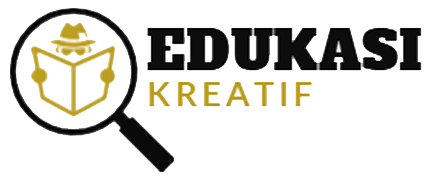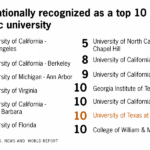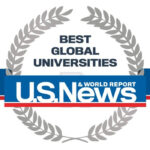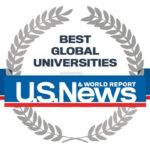Top ranked public universities represent a pinnacle of academic excellence, attracting students and faculty from around the globe. This guide delves into the multifaceted world of these institutions, exploring ranking methodologies, geographic distribution, academic strengths, student demographics, financial aspects, campus resources, career outcomes, research opportunities, and community impact. Understanding these factors is crucial for prospective students seeking a high-quality, publicly funded education.
We’ll examine various ranking systems, comparing their criteria and highlighting the strengths and weaknesses of each. Furthermore, we’ll explore the diverse range of academic programs offered, the financial aid options available, and the vibrant campus life that characterizes these leading universities. Finally, we’ll consider the significant contributions these institutions make to both their local communities and the global landscape.
Defining “Top Ranked”
The term “top-ranked” when applied to public universities is inherently subjective, depending heavily on the chosen ranking methodology. Numerous organizations employ different criteria and weighting schemes, resulting in varying rankings and a lack of a universally accepted “best” university. Understanding these methodologies is crucial for interpreting rankings and appreciating their limitations.
Different ranking systems utilize diverse metrics to assess universities, leading to different outcomes. The weight assigned to each criterion significantly influences the final ranking. For example, one system might prioritize research output, while another might emphasize student-to-faculty ratios or graduate employment rates. This lack of standardization necessitates a critical approach to interpreting any single ranking.
Ranking Methodologies Used for Public Universities
Several prominent organizations publish university rankings, each with its own methodology. These methodologies vary significantly, making direct comparisons challenging. Understanding the strengths and weaknesses of each system is vital for informed decision-making.
Comparison of Ranking Systems
Two prominent examples are the US News & World Report and Times Higher Education (THE) rankings. US News & World Report heavily emphasizes reputation surveys, while THE incorporates a broader range of factors, including research citations, teaching, and international outlook. These differences lead to different universities topping their respective lists.
Discussions about top-ranked public universities often involve intense debate. However, understanding the overall landscape requires considering a wide range of factors. To illustrate, one might examine the prestigious Cornell University, whose consistent high ranking is well-documented, as you can see by checking out its current standing at cornell university ranking. Ultimately, the “best” public university depends on individual needs and preferences, even with schools like Cornell consistently placing highly among their peers.
| Criterion | US News & World Report | Times Higher Education |
|---|---|---|
| Academic Reputation | High Weight | Moderate Weight |
| Faculty Resources | High Weight | Moderate Weight |
| Student Selectivity | High Weight | Low Weight |
| Graduation Rate Performance | High Weight | Low Weight |
| Research Output | Moderate Weight | High Weight |
| International Outlook | Low Weight | High Weight |
Criteria Considered in Each Ranking System
The specific criteria used by each ranking system are complex and often involve proprietary weighting algorithms. However, common factors include:
- Academic Reputation: Often based on peer assessments and surveys of academics.
- Research Output: Measured by citations, publications, and research funding.
- Faculty Resources: Including faculty-to-student ratios, faculty qualifications, and research funding per faculty member.
- Student Selectivity: Based on acceptance rates and applicant credentials.
- Graduation Rates: Reflecting student success and retention.
- Financial Resources: Indicating the university’s overall financial stability and investment in education.
- Alumni Giving: A measure of alumni satisfaction and engagement.
- International Outlook: Reflecting the international student population and faculty diversity.
Hypothetical Ranking System
A hypothetical ranking system could prioritize different criteria with assigned weights to reflect specific values. For instance, a system focused on social impact might prioritize community engagement and graduation rates for students from underrepresented backgrounds.
A hypothetical weighted ranking system could assign the following weights: Research Output (30%), Student Success (25%), Faculty Quality (20%), Diversity & Inclusion (15%), Community Engagement (10%).
Academic Program Strengths: Top Ranked Public Universities
Top-ranked public universities consistently excel across a wide spectrum of academic disciplines, attracting top faculty and students globally. Their strength lies not only in the breadth of programs offered but also in the depth of expertise and research capabilities within specific fields. Understanding these strengths is crucial for prospective students seeking a high-quality education and research opportunities.
Many top-ranked public universities offer a comprehensive range of academic programs, encompassing the humanities, social sciences, natural sciences, engineering, medicine, and business. However, certain institutions are particularly renowned for specific areas of study, often driven by historical strengths, significant research funding, and exceptional faculty. This specialization allows for a deeper dive into specific areas of knowledge, leading to breakthroughs in research and highly skilled graduates.
Common Academic Programs at Top-Ranked Public Universities
A typical list of prominent academic programs includes Engineering (various specializations like Aerospace, Chemical, Civil, Electrical, Mechanical, etc.), Computer Science, Business Administration (including MBA programs), Medicine (including specialized medical fields), Biological Sciences (covering areas like Biology, Genetics, Ecology, etc.), Physical Sciences (including Physics, Chemistry, Astronomy), and various Humanities and Social Science disciplines such as Economics, Political Science, History, and Literature. The specific programs and their sub-specializations can vary significantly between institutions.
Engineering Program Strengths at UC Berkeley and MIT (Comparison)
While not both public universities, comparing UC Berkeley and MIT highlights the variations in engineering program strengths. UC Berkeley boasts a strong emphasis on practical applications and societal impact, reflected in its extensive research collaborations with industry and government agencies. MIT, on the other hand, is often lauded for its highly theoretical and cutting-edge research, pushing the boundaries of engineering disciplines. Both institutions, however, produce highly sought-after graduates.
Many aspire to attend top-ranked public universities known for their academic excellence and research opportunities. Understanding the specific rankings is crucial for prospective students, and a good place to start is by examining the standing of institutions like the University of Colorado Boulder; you can find details on its ranking at university of colorado boulder ranking. Ultimately, the choice of university depends on individual needs and aspirations within the broader landscape of top-ranked public institutions.
For example, UC Berkeley’s Civil and Environmental Engineering department is known for its work on sustainable infrastructure and disaster resilience, while MIT’s Aeronautics and Astronautics department is a leader in aerospace research and development, consistently contributing to advancements in space exploration and aviation technology. The research output, measured by publications in high-impact journals and patents filed, demonstrates the distinct research focus of each institution.
Medical Program Strengths at UCLA and Johns Hopkins (Comparison)
While Johns Hopkins is a private institution, comparing it with UCLA illustrates the differences in medical program strengths. UCLA’s David Geffen School of Medicine excels in translational research, focusing on quickly moving research findings from the lab into clinical practice. Johns Hopkins, renowned for its strong history in medical research, maintains a significant focus on basic science research and groundbreaking discoveries in various medical fields. Both institutions attract highly competitive applicants and boast prominent faculty members who are leaders in their respective specialties. The quality of research is reflected in the number of clinical trials conducted, publications in prestigious medical journals, and the overall impact on patient care and medical advancements.
Faculty Expertise in Computer Science at Carnegie Mellon University and University of Illinois Urbana-Champaign, Top ranked public universities
Carnegie Mellon University (a private institution) and the University of Illinois Urbana-Champaign both house world-renowned computer science departments. However, their strengths often lie in different areas. CMU, for instance, is known for its strong focus on artificial intelligence and robotics, attracting leading researchers in these fields. The University of Illinois Urbana-Champaign, on the other hand, has a broad and deep computer science program with strengths in areas such as high-performance computing and databases. The faculty expertise is evident in the numerous awards, grants, and publications produced by professors within each institution.
Campus Resources and Facilities
Top-ranked public universities are renowned not only for their academic rigor but also for the comprehensive resources and facilities they provide to students and faculty. These resources extend far beyond classrooms and libraries, creating a supportive and enriching environment conducive to learning, research, and personal growth. Access to cutting-edge technology, state-of-the-art research labs, and diverse recreational opportunities are integral components of the overall student experience at these institutions.
These institutions invest heavily in creating a vibrant campus life, recognizing that a holistic approach to education fosters success. The availability of comprehensive support services, including career counseling, health and wellness centers, and robust student organizations, contributes significantly to the overall positive experience and contributes to student success and well-being. The quality and breadth of these resources are often key factors in a prospective student’s decision-making process.
Examples of Innovative Learning Spaces
Many top-ranked public universities are embracing innovative pedagogical approaches by creating flexible and collaborative learning environments. For example, University of California, Berkeley’s Dwinelle Hall features active learning classrooms designed to promote student interaction and engagement. These classrooms often include flexible furniture arrangements, technology integration for collaborative projects, and breakout spaces for small group discussions. Similarly, the University of Michigan has invested in numerous maker spaces, providing students with access to advanced technology and equipment for hands-on projects, fostering creativity and innovation across various disciplines. These spaces encourage interdisciplinary collaboration and the development of practical skills. The University of Virginia’s new prototyping lab, equipped with 3D printers and other advanced fabrication tools, exemplifies the trend towards providing students with resources to translate their ideas into tangible prototypes.
Examples of Advanced Research Facilities
Top-ranked public universities often house world-class research facilities that attract leading researchers and provide students with invaluable research opportunities. For instance, the University of Texas at Austin’s Microelectronics Research Center boasts cutting-edge cleanroom facilities used for the development of advanced semiconductor technologies. This facility attracts significant research funding and offers unique learning opportunities for students in engineering and related fields. The National Center for Supercomputing Applications (NCSA) at the University of Illinois Urbana-Champaign provides researchers with access to high-performance computing resources, supporting groundbreaking research in various fields, including bioinformatics, climate modeling, and materials science. Furthermore, the California Institute of Technology (Caltech), while a private institution, provides an excellent example of advanced research facilities available at top institutions, with its renowned Jet Propulsion Laboratory playing a vital role in space exploration. Students have access to and learn from the cutting-edge technology and research projects undertaken there.
Comparative Analysis of Campus Resources
A comparative analysis of campus resources across several top-ranked public universities reveals significant similarities and some key differences. While all institutions generally offer comprehensive libraries, health services, and recreational facilities, the specific offerings and the scale of these resources can vary considerably. For example, the University of California, Los Angeles (UCLA) and the University of California, Berkeley, both boast extensive library systems and numerous research centers, but UCLA might have a stronger emphasis on film and media studies resources, while Berkeley might have a more pronounced focus on environmental research facilities. Similarly, the University of Texas at Austin and the University of Michigan might both offer extensive athletic facilities, but their specific sports programs and the overall size and scope of their athletic departments could differ. The availability of specialized facilities, such as art studios, music conservatories, or advanced engineering labs, also varies considerably depending on the institution’s specific academic strengths and research priorities. These differences reflect the unique character and focus of each institution, offering prospective students a diverse range of choices.
Impact on Local and Global Communities
Top-ranked public universities act as powerful engines for societal advancement, contributing significantly to both their immediate communities and the global landscape. Their influence extends beyond academic pursuits, encompassing economic development, cultural enrichment, and the advancement of knowledge that benefits all of humankind. This impact is multifaceted and deeply interwoven with the university’s mission and the actions of its faculty, students, and staff.
The contributions of these institutions are evident in various ways. Locally, they provide highly skilled graduates who contribute to the workforce, bolstering the regional economy. They often serve as centers for innovation and entrepreneurship, fostering the creation of new businesses and jobs. Furthermore, many engage in community outreach programs, offering valuable services and expertise to local residents. Globally, these universities are at the forefront of research and discovery, addressing critical challenges such as climate change, disease, and poverty. Their international collaborations and partnerships facilitate the exchange of knowledge and expertise, fostering global understanding and cooperation.
Local Community Contributions
Top-ranked public universities significantly boost their local economies through several avenues. They generate substantial revenue through tuition fees, research grants, and campus operations, supporting local businesses and creating employment opportunities. Graduates often choose to remain in the area, contributing their skills and expertise to the local workforce. Many universities also offer community services such as adult education programs, healthcare clinics, and cultural events, enriching the lives of local residents and strengthening community bonds. The presence of a prestigious university enhances a city’s reputation, attracting businesses and investment, thereby stimulating economic growth. For example, the University of California, Berkeley’s presence has significantly contributed to the Bay Area’s vibrant tech industry, while the University of Texas at Austin has played a key role in the growth of Austin’s economy.
Global Impact through Research and Collaboration
Research conducted at top-ranked public universities frequently addresses global challenges. Breakthroughs in medicine, engineering, and other fields often originate from these institutions, leading to advancements that benefit people worldwide. International collaborations are common, with researchers from different countries working together on joint projects. These collaborations foster the exchange of ideas, promote scientific innovation, and help to address global issues more effectively. For instance, many universities participate in international research consortia focused on combating climate change or developing sustainable energy solutions. Furthermore, these universities often engage in outreach programs in developing countries, providing educational opportunities and technical assistance.
Examples of Community Engagement Initiatives
The following universities demonstrate a strong commitment to community engagement through diverse initiatives:
- University of Michigan: Offers numerous volunteer opportunities for students, engages in K-12 outreach programs, and provides community-based research opportunities.
- University of California, Berkeley: Supports numerous community gardens, provides resources for local businesses, and offers extensive public lectures and events.
- University of Texas at Austin: Partners with local organizations on numerous initiatives, conducts community-based research, and provides extensive support to underserved communities.
- University of Washington: Engages in extensive community partnerships, focusing on issues such as public health, environmental sustainability, and economic development.
- University of Illinois at Urbana-Champaign: Offers numerous community engagement programs, including service-learning opportunities, community-based research projects, and partnerships with local organizations.
Choosing a university is a significant decision, and selecting from among the top-ranked public institutions requires careful consideration of numerous factors. This guide has provided a framework for understanding these factors, from academic excellence and financial accessibility to campus resources and career prospects. By weighing the strengths and weaknesses of various universities based on individual needs and priorities, prospective students can make an informed choice that sets them on a path toward a successful and fulfilling future.





